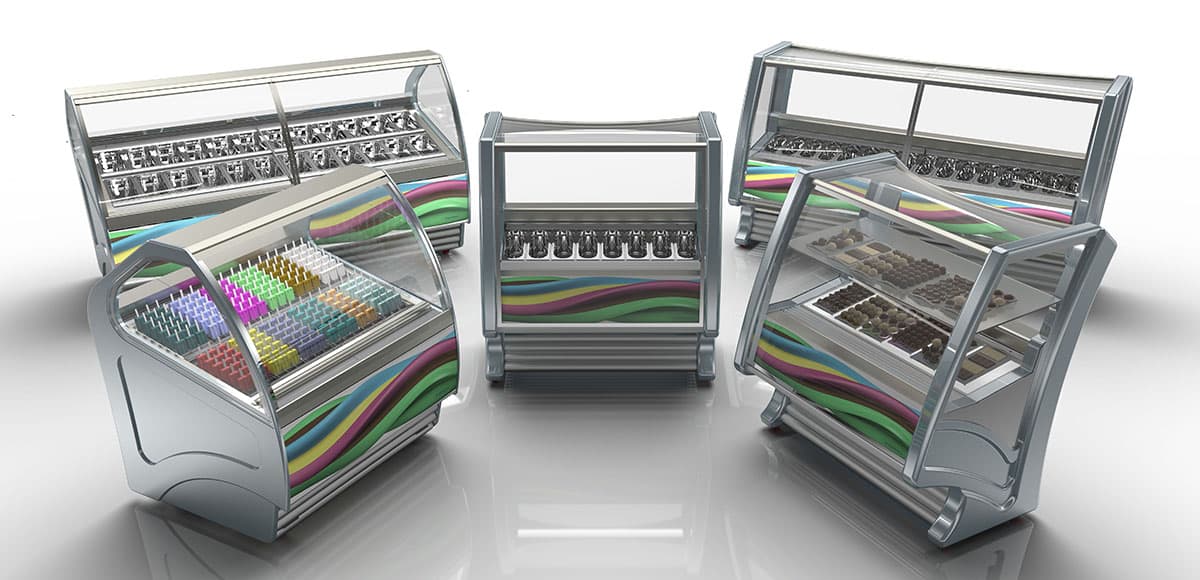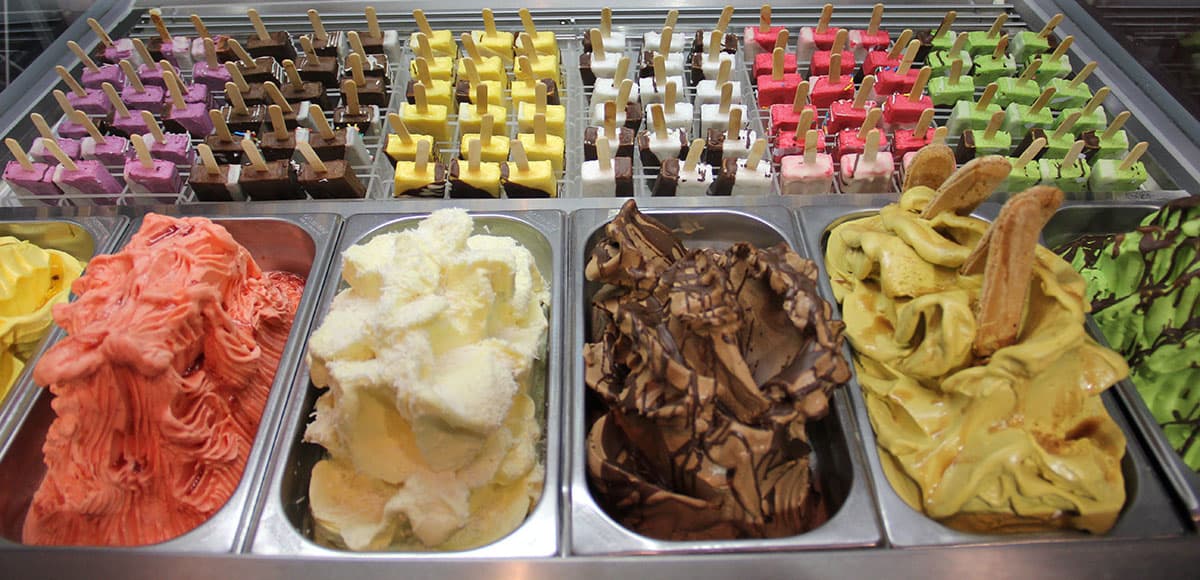


The first ice cream machines relied upon the strength of the operator. With time, muscle was substituted with electrical engines. Less effort was required of the operator, but the main functions and operations were still performed by him/her
Ice cream, chocolates, and other kinds of food, go through the similar process of beating the ingredients, at either low or high temperatures, sometimes softly and sometimes vigorously. Breads, sweets, pastas, generally follow the same steps. To effectively execute this procedure, machines are given mechanical motorized systems that replace the need for people.
Thanks to industrialization, the food preparation phase is no longer a tedious process. Detail-oriented and demanding tasks seen to by machines avoid the costly mistakes caused by human error. Ice creams and handmade chocolates, still require that special ‘human touch’, but by incorporating sophisticated automated systems into the pasteurization and tempering processes, the rigorous control needed for high-quality products is easily attained.
The latest phase of technological evolution came with the emergency of 'artificial intelligence', which uses computer codes that literally 'think' about what is the best action to take when confronted with a series of variables. A game of chess played against a computer is the perfect example: The human player makes a move a waits for the computer to analyze all the possible alternatives, it then chooses the best move based on a series of codes that have pre-established criteria.
Industrial equipment for the production of ice creams, popsicles, and chocolates already use, although modestly, artificial intelligence.
Finamac™, in partnership with universities and specialized companies, developed a robotic laboratory to research new ways to use intelligent automated machinery. See one of the resulting machines bellow:
Equipment for the packing of ice creams on cones, cups ,or pots. Electro mechanic technology from the 70’s:
Since 1954, Finamac™ has been in the ice cream and food market. We operated ice cream shops long before we even considered making machines.
As a boy, Finamac’s founder came down with facial paralysis caused by heat shock when eating popsicles in a very hot day. It took 6 months of physical therapy and electric shock for him to recover. All the while, he continued to frantically eat up all the ice cream at the ice cream shop. As an adult, the boy took the initiative to start manufacturing industrial equipment. In 1989, he founded Finamac™.
Our passion for ice cream, chocolates, and food in general has never waned. Our team has the knowledge and the vision to design equipment that generates food with more flavor and higher quality.
Finamac™ has always maintained an area dedicated to food; after all, we started as an ice cream parlor. This space is used to teach several courses and test out all of the equipment with a variety of products.
Over the years, we have had the opportunity of working with and supplying a variety of small and large producer of ice cream, including Unilever and Nestle. It has helped us to gain a deeper understanding of the relationship between food quality and the finish product.
We understand that regional considerations must be taken into account when producing food. Italian ice cream, for example, are made with beet sugar, unlike the ice cream made with sugar cane typically found in Brazil.
Accounting for the tastes and the available of raw materials from different regions around the world, can optimize the performance and ease the operation of certain machines. This is not easy and requires a lot of research and innovation. For example, Italian ice cream machines must use significantly higher power to produce ice cream in Brazil. This doesn’t mean that this machine or another country have greater or lesser quality ice cream.
The factors that contribute to the quality of food are much more complicated than the sophistication of its manufacturing process. A lot of it has to do with regional tastes and demand. For food to meet with success, the whole chain of consumption must be considered, analyzing the different commercial and palatability factors.
The first ice cream machines used snow and salt wrapped around a metal container where the ingredients were beaten. With the emergence of industrial refrigeration, ice cream production has seen incredible progress, as well as the preservation of many other foods.
On the other hand, fire has been around for a long ago. But this combination of heating and cooling led to more elaborate processes, such as the pasteurization of milk and the tempering of chocolate.
Thermal processes are currently used in the preparation of most foods, but have a special importance in making ice cream.
As the world continues to put a tremendous importance on energy, heat generation is gaining in value. Considering that the world we live in is warmed by the sun and that without it we would be frozen, we understand that cold is merely the absence of heat.
The study of thermal processes is a fundamental step in the research of producing ice cream, chocolates, and so forth. The Finamac™ lab has developed a system of thermal analysis in order to further understand the phenomena involved and seek new alternatives for the transmission of energy between food and the environment.
Below you can see the first pasteurizer that uses a heat pump, patented and developed by thc Finamac™ research team:
This machine is a valuable example of potential ways to use energy. The same heat exchange system that generates heat to warm the ice cream mix is also used to cool it, thereby eliminating the need for gas or electric heaters (fire), which are much more expensive and harmful to the environment.

During the industrial revolution, the word "machine" became a status symbol, and the more rough and rugged the design, the better. For many years the machine itself was more important than the product it offered. Advertisements focused on ice cream machines in the same way that wood-fired oven pizza are advertised today.
Although the advertising has changed, there still remains a strong bond between ice cream or popsicles and the machines that produce them. And for good reason. You can not produce a quality product without a quality machine.
Out of sight, out of mind
For many years, the strategy has been to prominently place the product but keep the ice cream machine hidden. The reason may have been hygienic or strategic, but it always remained the same - customers were not allowed see the production process.
Ice cream in an impulse purchase. It calls out to the heart and the palate when simply displayed in a freezer. Then came the concept of Italian gelato, exposing the naked ice cream without the packaging, but the equipment still remained hidden - out of sight, out of mind. Then McDonald's was the first to expose their product’s machine to the customer; unfortunately they gained little in the way of attractiveness, their machine looks like a tank.
Contemporary design
Bringing the machine forefront of ice cream business was a challenge that we decided to take on. Transforming industrial monsters into modern visual equipment has always been a part of our plans. From the beginning, our patented industrial models were copied, and now dictate market trends. The first ice lolly with a fiberglass tank (Fig. 1), replacing the steel, was made here.

Fig 1. First ice lolly with fiberglass tank.
We ended the "electric shock" problems of touching the stainless steel tank, as well as the frozen surface that inhibited any one to lay their hand on the machine, as well as the problems of leakage, costs, etc. We were also first producer of ice cream to use plastic lids (Fig. 2).
Fig 2. Largest producer of ice cream to use plastic lids.
Being a thermal insulator, it prevents the drip-drip of condensation from traditional stainless steel doors, and it can use elegant shapes and attractive colors. We made the first machines to use stainless steel cabinets with color. They are suitable for a variety of environments, such as sophisticated coffee machines, usually finishing with navy blue or gold.
Machines that weighed almost 500 pounds now weigh just over 100kg, after total change in the construction concept.
Our display cases exhibiting Italian ice cream, which can be seen in shopping malls and luxury ice cream in affluent neighborhoods, are unique in Brazil and compete with the best European products, with the advantage of being tropicalized and having tempered glass that do not fog up. See fig. 3 below.

Fig 3. Thermo conductive glass is used for the windows. Image rendered at the research center of Finamac™, starting from CAD files.
